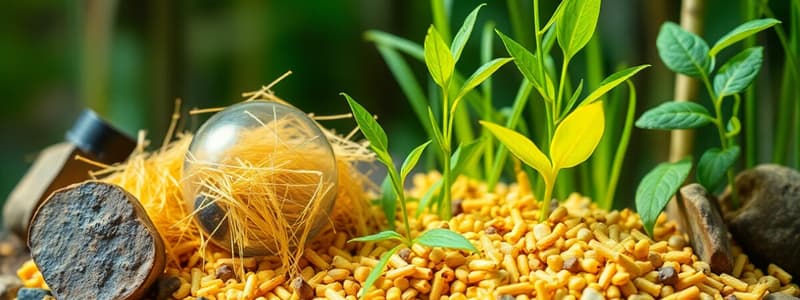Podcast
Questions and Answers
What is the primary source of energy for biomass?
What is the primary source of energy for biomass?
- Sunlight (correct)
- Natural gas
- Fossil fuels
- Renewable resources
Which of the following is an example of non-woody biomass?
Which of the following is an example of non-woody biomass?
- Oil palm
- Coconut
- Pine
- Seaweed (correct)
How is biomass typically converted into electricity?
How is biomass typically converted into electricity?
- Fermentation
- Chemical conversion
- Burning (correct)
- Bacterial decay
What gas is produced when bacteria feed on dead organic matter?
What gas is produced when bacteria feed on dead organic matter?
Which process involves adding yeast to biomass to produce a specific type of fuel?
Which process involves adding yeast to biomass to produce a specific type of fuel?
What type of biomass is generally used directly to provide heat for homes?
What type of biomass is generally used directly to provide heat for homes?
Which of the following types of biomass can be processed to produce liquid biofuels?
Which of the following types of biomass can be processed to produce liquid biofuels?
Which component of biomass is primarily responsible for providing strength?
Which component of biomass is primarily responsible for providing strength?
Which method converts biomass into gas or liquid fuels using heat or chemicals?
Which method converts biomass into gas or liquid fuels using heat or chemicals?
What is a primary environmental advantage of using biomass over fossil fuels?
What is a primary environmental advantage of using biomass over fossil fuels?
Which of the following is NOT considered a natural raw material for biomass?
Which of the following is NOT considered a natural raw material for biomass?
What is the main purpose of fermentation in biomass strategies?
What is the main purpose of fermentation in biomass strategies?
Which biomass component is typically burned for energy in biorefineries?
Which biomass component is typically burned for energy in biorefineries?
What is a primary step in the production of wine from grapes?
What is a primary step in the production of wine from grapes?
Which of the following is a product of the fermentation process in biomass strategies?
Which of the following is a product of the fermentation process in biomass strategies?
What percentage of the biomass used today comes from burning wood and wood scraps?
What percentage of the biomass used today comes from burning wood and wood scraps?
What is the principal white wine grape variety in California that accounts for the highest percentage?
What is the principal white wine grape variety in California that accounts for the highest percentage?
Which ingredient in beer production is primarily responsible for fermentation?
Which ingredient in beer production is primarily responsible for fermentation?
What temperature range does ale yeast prefer for fermentation?
What temperature range does ale yeast prefer for fermentation?
What role do hops play in beer production?
What role do hops play in beer production?
Which of the following grape varieties accounts for the lowest percentage of white wine production in California?
Which of the following grape varieties accounts for the lowest percentage of white wine production in California?
What is the primary base ingredient of beer, providing essential sugars for fermentation?
What is the primary base ingredient of beer, providing essential sugars for fermentation?
Which type of yeast is generally used for bottom fermenting beers?
Which type of yeast is generally used for bottom fermenting beers?
During fermentation, what type of pH do yeasts typically favor?
During fermentation, what type of pH do yeasts typically favor?
What is the purpose of mashing during beer production?
What is the purpose of mashing during beer production?
At which temperature do the enzymes known as diastases become most active during mashing?
At which temperature do the enzymes known as diastases become most active during mashing?
Which equipment is essential for cooling down the wort after boiling?
Which equipment is essential for cooling down the wort after boiling?
What process follows malting in beer production?
What process follows malting in beer production?
During which step of beer production is the sweet liquid called 'wort' created?
During which step of beer production is the sweet liquid called 'wort' created?
What is one of the final steps in the beer production process before approval from regulatory bodies?
What is one of the final steps in the beer production process before approval from regulatory bodies?
What action is taken with barley grains during the malting stage?
What action is taken with barley grains during the malting stage?
What role does fermentation by yeast play in beer production?
What role does fermentation by yeast play in beer production?
Flashcards are hidden until you start studying
Study Notes
Biomass as a Biotechnology Substrate
- Biomass is defined as dead organic matter, including examples like corn kernels, algae mats, and sugarcane stalks.
- Sources of biomass include wood, crops, seaweed, and animal waste, recognized as one of humanity's oldest energy sources.
- Classification of biomass:
- Woody Biomass: Includes coconut, oil palm, poplar, and pine, primarily utilized for heating and electricity generation.
- Non-Woody Biomass: Comprises corn, sugarcane, soybeans, and algae, often processed for liquid biofuels.
Energy Conversion from Biomass
- Biomass derives energy from sunlight through photosynthesis, transforming water, carbon dioxide, and minerals into oxygen and sugars (carbohydrates).
- Four methods to convert biomass into energy:
- Burning: Generates steam for electricity or heat for industrial and residential use.
- Bacterial Decay: Decomposing organic matter produces methane gas, akin to natural gas.
- Fermentation: Yeast converts sugars in biomass into ethanol, essential in alcoholic beverage production.
- Chemical Conversion: Biomass can be chemically altered into gas or liquid fuels, such as converting animal manure to methane for electricity.
Biomass Types and Their Uses
- Alcohol Fuels: Examples include ethanol, methanol, and gasohol (blend of gasoline and ethanol).
- Wood and Agricultural Wastes: Source of solid biomass for energy generation.
- Landfill Gas: By-products like methane gas and biogas are produced from organic waste.
Biomass Production Strategies
- Sustainability and cost-effectiveness are crucial for biomass selection processes, emphasizing accessible raw materials.
- Key components of biomass include cellulose (strength), hemicellulose (flexibility), and lignin (adhesive properties).
- Example raw materials for biofuels and production:
- Grapes (wine), malted barley (beer), cane molasses (bioethanol), and rice bran (edible oil).
Wine Production Process
- Steps in white wine production:
- Crushing and destemming grapes, followed by pressing, fermentation with yeast, and subsequent purification and processing.
- Principal grape varieties in California include Thompson Seedless, Chardonnay, French Colombard, Chenin Blanc, and Sauvignon Blanc.
Beer Production Process
- Key ingredients: malted barley (sugar source), hops (flavoring and preservation agent), yeast (fermentation), and water.
- Barley undergoes malting, mashing, and fermentation to produce beer, with variations in yeast type impacting flavor profiles.
- Equipment used includes boiling kettles, fermentation vessels, and cooling coils.
Environmental Advantages of Biomass
- Biomass releases low sulfur and nitrogen pollutants, contributing to reduced acid rain.
- Plant growth absorbs CO2, mitigating global warming effects.
Market Potential of Biomass Components
- Each biomass component has market applicability; cellulose is valuable for higher-end applications, while hemicellulose and lignin serve primarily for energy in biorefineries.
- Examples of biomass utilities: potato waste for amylase production and husk for bioethanol.
Studying That Suits You
Use AI to generate personalized quizzes and flashcards to suit your learning preferences.




